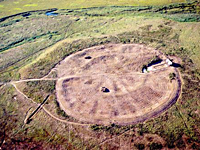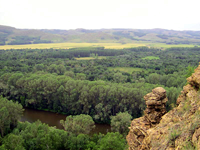 |
Home page / Regions
/ The Urals Federal District
/ The Chelyabinsk Oblast
/ Social and natural resources
|
|
|
Social and natural resourcesHistory People have been living in the South Urals since ancient times. Numerous dwelling sites of Stone Age man and settlements from Bronze and Iron Ages were discovered here. A paleolithic picture gallery has been established in the world-famous Ignatiev Cave. It has paintings made by primeval man more than 14,000 years ago.
In the ancient and early medieval time, the Scythians and Sarmatians roamed here. Within the oblast, there is a lot of burial hills where tribal chieftains were buried. Time and again, archeologists find untouched burial grounds with golden adornments and weapons.
Geography, natural resources The south-eastern part of the Oblast borders on Kazakhstan (the length of the frontier zone is 730 kilometres).The natural landscape of the Oblast is diverse: it has mountains, forests, forest steppes, and steppes. It has many rivers, the Ural and the Miass being the main ones. There are 3,170 lakes within the region. Many of them are saline, rich in organic and mineral muds and alkaline waters. Due to this, the health resort system is well-developed. Forests are concentrated in the mountain belt and amount to 27% of the region’s territory. The share of coniferous forests that are economically usable is over 2.8 million hectares. Out of 1,500 species of plants that grow in the region, about 150 are widely used in the official and ethnic medicine. The favourable geographic position creates unique opportunities for the development of alpine ski tourism. The Oblast has a total of 20 alpine ski centres. The biggest ones – Abzakovo, Metallurg-Magnitogorsk, Adjigardak, and Zavyalikha – comply with European standards and welcome foreign tourists. The South Urals are very interesting for the development of mountain climbing, cave tourism, water sports and other extreme leisure activities in the wilderness.
The Chelyabinsk Oblast has significant reserves of natural resources. Of utmost significance are the deposits of iron and copper-zinc ores, gold, refractory raw material, talcum, graphite, and quartz. Iron ores are concentrated in 24 proven deposits with a total reserve of 832 million tons. The Oblast is rich in high-quality marble; its proven reserves amount to more than 10 million cubic metres. In several districts, gems and ornamental stones can be found.
Cities and population In terms of the population (3.5 million), the Chelyabinsk Oblast ranks 9th in Russia. In terms of the population density – 39.7 per square metre – the Oblast ranks 1st amongst the Urals regions. The economically active population is 1,765 thousand people. Over 80% of the population live in cities. The biggest cities are: Chelyabinsk with a population of 1.1 million; Magnitogorsk, 409 thousand; Zlatoust, 191 thousand; and Miass, 167 thousand.
Science There are 34 higher education establishments in the Chelyabinsk Oblast; the most outstanding ones are the South Urals and Chelyabinsk state universities, agricultural engineering and pedagogical universities, a medical academy, and a physical training academy. 40 entities are involved with R&D, design and engineering activities in the Oblast. The total number of students in the higher educational establishments is 171,000.
|
|
| Regions | Project participants | Investment projects | Consulates and Trade Offices | News and Analysis | About the Project |
|
© RusBusinessNews, 2009. All rights reserved. Establishing a hyperlink to RIA RusBusinessNews is required for using any of the material published on this website. News and analytical reviews are translated into foreign languages by the TRANSLIT Translation Agency |
«Sum of technologies»® Web design Site promotion |




